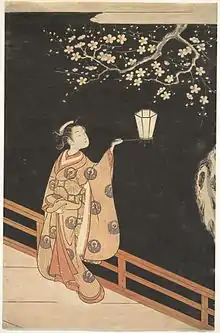In a Station of the Metro
"In A Station of the Metro" is an Imagist poem by Ezra Pound published in April 1913[1] in the literary magazine Poetry.[2] In the poem, Pound describes a moment in the underground metro station in Paris in 1912; he suggested that the faces of the individuals in the metro were best put into a poem not with a description but with an "equation". Because of the treatment of the subject's appearance by way of the poem's own visuality, it is considered a quintessential Imagist text.[3]
It is sometimes considered to be the first haiku published in English,[1] though it lacks the traditional 3-line, 17-syllable structure of haiku.
The poem was reprinted in Pound's collection Lustra in 1917, and again in the 1926 anthology Personae: The Collected Poems of Ezra Pound, which compiled his early pre-Hugh Selwyn Mauberley works.
The poem
The apparition of these faces in the crowd:
Petals on a wet, black bough.
The poem contains only fourteen words (without a verb therein—making it a good example of the verbless poetry form).[4]
Pound was influential in the creation of Imagist poetry until he left the movement to embrace Vorticism in 1914. Pound, though briefly, embraced Imagism stating that it was an important step away from the verbose style of Victorian literature and suggested that it "is the sort of American stuff I can show here in Paris without its being ridiculed".[5] "In a Station of the Metro" is an early work of Modernist poetry as it attempts to "break from the pentameter", incorporates the use of visual spacing as a poetic device, and does not contain any verbs.[3] The work originally appeared with different spacing between the groups of words. This can be found in the on-line version of Poetry magazine for April 1913.
Analysis
The poem was first published in 1913 and is considered one of the leading poems of the Imagist tradition. Pound's process of deletion from thirty lines[6] to only fourteen words typifies Imagism's focus on economy of language, precision of imagery and experimenting with non-traditional verse forms. The poem is Pound’s written equivalent for the moment of revelation and intense emotion he felt at the Paris Metro's Concorde station.
The poem is essentially a set of images that have unexpected likeness and convey the rare emotion that Pound was experiencing at that time. Arguably the heart of the poem is not the first line, nor the second, but the mental process that links the two together. "In a poem of this sort," as Pound explained, "one is trying to record the precise instant when a thing outward and objective transforms itself, or darts into a thing inward and subjective."[7]

Woman Admiring Plum Blossoms at Night, Suzuki Harunobu, 18th century
Like other modernist artists of the period, Pound found inspiration in Japanese art, but the tendency was to re-make and to meld cultural styles rather than to copy directly or slavishly. He may have been inspired by a Suzuki Harunobu print he almost certainly saw in the British Library (Richard Aldington mentions the specific prints he matched to verse), and probably attempted to write haiku-like verse during this period.[8]
See also
References
- Higginson, William J. (1985). The Haiku Handbook: How to Write, Share, and Teach Haiku. Tokyo: Kodansha International (published 1989). p. 51.
Six months after Poetry magazine began, in the issue of April 1913, Ezra Pound's now famous 'In a Station of the Metro' appeared. This may be the first published hokku in English.
- Axelrod, Steven Gould and Camille Roman, Thomas J. Travisano.The New Anthology of American Poetry: Traditions and Revolutions, Beginnings to 1900.Rutgers University Press (2003) p.663
- Barbarese, J.T. "Ezra Pound's Imagist Aesthetics: Lustra to Mauberley" The Columbia history of American poetryColumbia University Press (1993) pp.307-308
- Hirsch, Edward 'A Poet's Glossary' Houghton Mi n, 2014
- Ayers, David. Modernsim: A Short Introduction. Blackwell (2004) p.2
- "On "In a Station of the Metro"". www.english.illinois.edu.
- Pound (1916) Gaudier-Brzeska, 103. https://archive.org/details/gaudierbrzeska00pounrich
- Video of a lecture discussing the importance of Japanese culture to Pound's early poetry, London University School of Advanced Study, March 2012.
Wall Street journal, Jan 7-8, 2017 Page C14 review by Willard Spiegelman
Sources
- Ezra Pound "Vorticism", in The Fortnightly Review, Sept. 1, 1914
- The Cat Empire, "The Crowd", Nov/Dec, 2004
External links
| Wikisource has original text related to this article: |